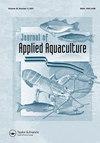槲皮素负载介孔二氧化硅纳米颗粒(QMSNs)对尼罗罗非鱼免疫和抗病性的影响
IF 0.8
Q3 FISHERIES
引用次数: 1
摘要
摘要:本研究旨在探讨槲皮素负载介孔二氧化硅纳米颗粒(QMSNs)提高尼罗罗非鱼(Oreochromis niloticus)抗病性和免疫反应的潜力。本研究采用5个实验组,平均体重为0.69±0.31 g;3组饲喂槲皮素负载介孔二氧化硅纳米颗粒(QMSNs)饲粮(0.25 g kg - 1 - QMSNs 0.25、0.50 g kg - 1 - QMSNs 0.50、1 g kg - 1 - QMSNs 1),对照组饲喂不添加添加剂的基础饲粮。第五组为纯槲皮素饲粮(0.25 g kg−1 - QMD)。在肺炎克雷伯菌和无乳链球菌试验攻毒前进行90天的饲养试验。饲粮中添加槲皮素的介孔二氧化硅纳米颗粒(QMSNs)显著提高了消化酶、吞噬指数、潜在杀伤活性、呼吸爆发活性和血清抗菌活性,尤其是添加量为0.50 g kg−1时。此外,在饲料中添加0.50 g kg−1 QMSNs的鱼的肌肉和肝胰腺中,抗氧化相关基因[超氧化物歧化酶(SOD)和过氧化氢酶(CAT)]和代谢酶[血清谷草酰乙酸转氨酶(AST)和血清谷丙转氨酶(ALT)]均出现上调。在第15天激射期结束时,0.50 g kg - 1 QMSNs组的存活率显著高于其他所有处理组。因此,0.50 g kg−1 QMSNs饲喂尼罗罗非鱼90天可能足以提高鱼的免疫反应、抗氧化能力和抗肺炎克雷伯菌和无乳链球菌的存活率。因此,槲皮素负载的介孔二氧化硅纳米颗粒(QMSNs)可推荐作为尼罗罗非鱼抗肺炎克雷伯菌和无乳链球菌的膳食替代品。本文章由计算机程序翻译,如有差异,请以英文原文为准。
Influence of quercetin loaded mesoporous silica nanoparticles (QMSNs) on immunity and diseases resistance in Nile tilapia (Oreochromis niloticus)
ABSTRACT The aim of the present study is to scrutinize the potentiality of Quercetin loaded mesoporous silica nanoparticles (QMSNs) to improve the disease resistance and immune response in Nile tilapia (Oreochromis niloticus). The study used five experimental groups of fish with a mean weight of 0.69 ± 0.31 g; three groups were fed quercetin loaded mesoporous silica nanoparticles (QMSNs) incorporated diets (0.25 g kg−1 – QMSNs 0.25, 0.50 g kg−1 – QMSNs 0.50, 1 g kg−1 – QMSNs 1), while the control group was fed an additive-free basal diet. The fifth group was a strict quercetin-only diet (0.25 g kg−1 – QMD). Feeding trial was done for 90 days prior to the experimental challenge with Klebsiella pneumoniae and Streptococcus agalactiae. Dietary quercetin loaded mesoporous silica nanoparticles (QMSNs) especially at 0.50 g kg−1 significantly increased digestive enzymes, phagocytic index, potential killing activity, respiratory burst activity, and Serum antibacterial activity. Furthermore, antioxidant-related genes [superoxide dismutase (SOD) and catalase (CAT)] and metabolic enzymes [serum glutamic oxaloacetic transaminase (AST) and serum glutamic pyruvic transaminase (ALT)] were found to be upregulated in the muscle and hepatopancreases of fish fed with 0.50 g kg−1 QMSNs. Survival rates were significantly higher in the 0.50 g kg−1 QMSNs group at the end of the 15th day challenge period compared to all other treatment groups. As a result, feeding Nile tilapia with 0.50 g kg−1 QMSNs for 90 days may be sufficient to improve fish immune response, antioxidant status, and survival rate against Klebsiella pneumoniae and Streptococcus agalactiae. As a result, quercetin loaded mesoporous silica nanoparticles (QMSNs) can be recommended as a dietary substitute against K.pneumoniae and S. agalactiae in Nile tilapia.
求助全文
通过发布文献求助,成功后即可免费获取论文全文。
去求助
来源期刊

Journal of Applied Aquaculture
Environmental Science-Ecology
CiteScore
3.20
自引率
0.00%
发文量
38
期刊介绍:
The Journal of Applied Aquaculture is a platform for the sharing of practical information needed by researchers to meet the needs of investors, farm managers, extension agents and policy makers working to adapt aquaculture theory to achieve economic and food security objectives in the real world. The journal emphasizes multi-disciplinary research and case studies that propose financially and logistically viable solutions to observable problems.
 求助内容:
求助内容: 应助结果提醒方式:
应助结果提醒方式:


